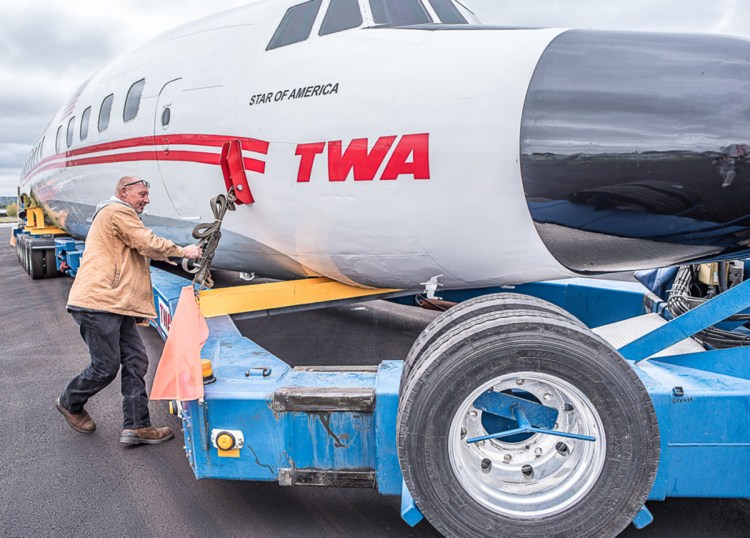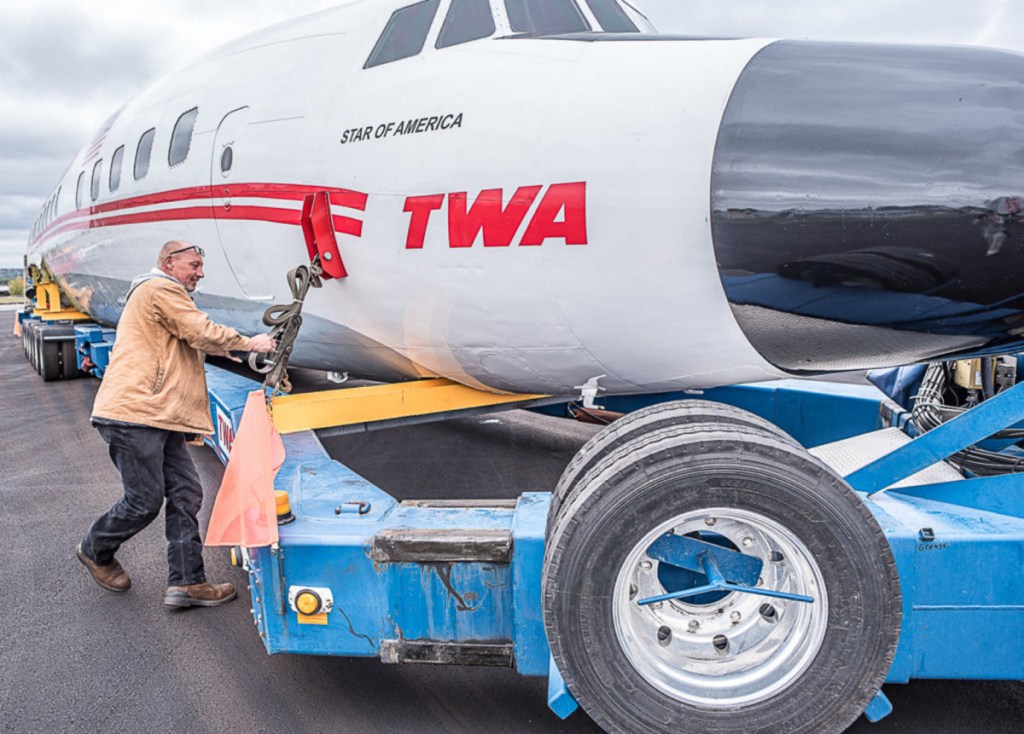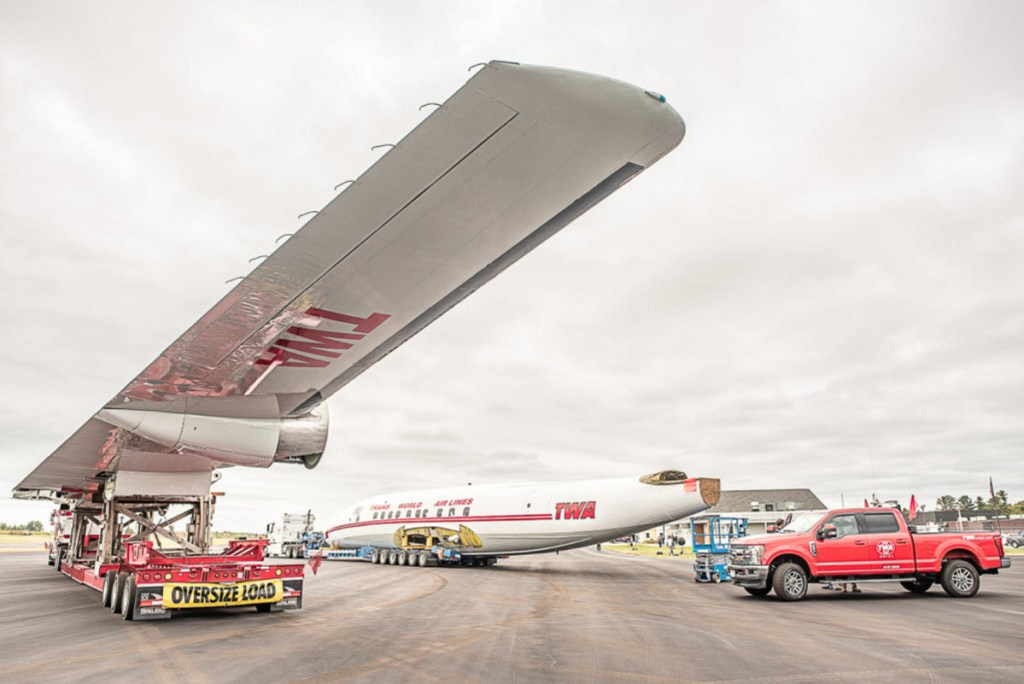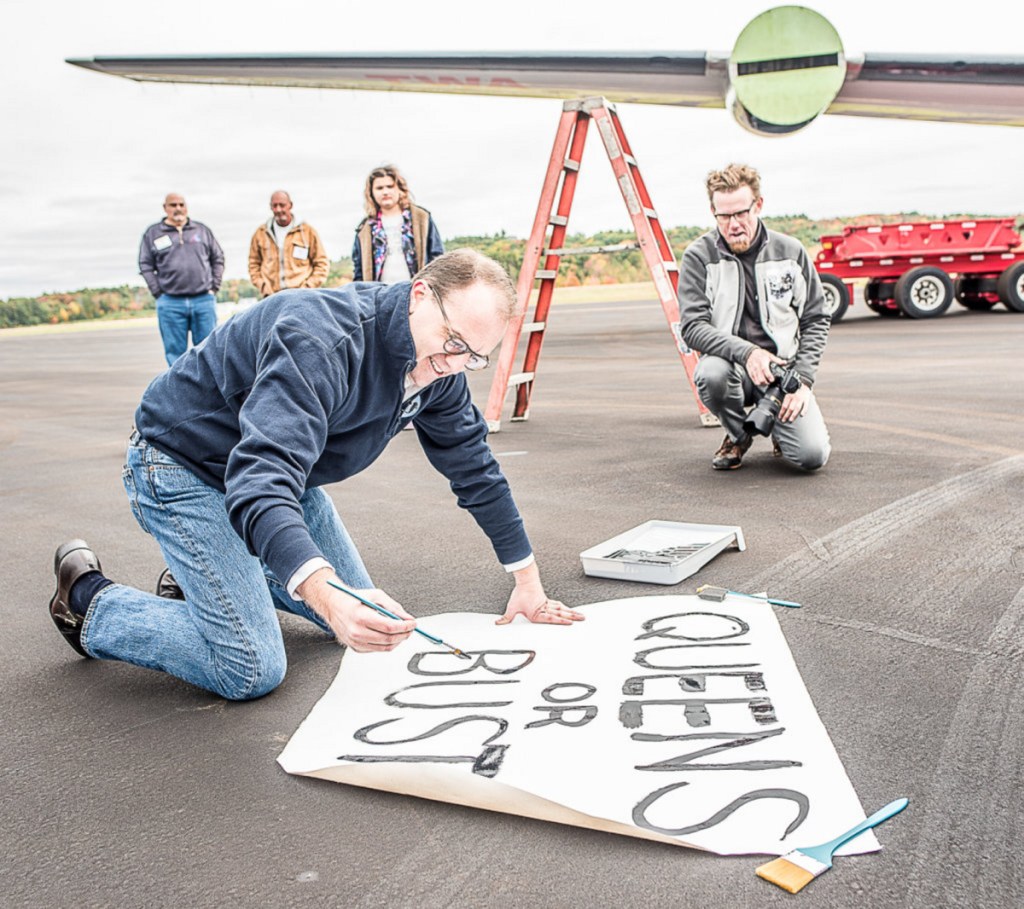AUBURN — After sitting outside the Auburn-Lewiston Airport for 30 years, a rare Lockheed L-1649A “Super Star” Constellation with a new face-lift is headed to New York City to become a cocktail lounge outside John F. Kennedy International Airport.
It’s part of a massive, new 512-room hotel development at the former TWA terminal.
During a ceremonial send-off Monday, Tyler Morse, CEO of MCR and Morse Development, which are behind the TWA Hotel project, hand-painted a “Queens or bust!” sign and hung it on the back of the 150-foot fuselage as it sat on the back of a flatbed at the airport.
“It’s amazing; she looks beautiful,” said Morse.
It will start the 328-mile journey to JFK at 7 a.m. Tuesday, part of a six-truck, mile-long convoy.
The plane, built in 1958, is one of two Constellations once owned by Maurice Roundy and parked since the 1980s by the A-L airport. The other Constellation there is currently packed up and waiting to head back to Germany after a decade-long effort by Lufthansa Technik to try to return it to flying shape.
The plane headed to JFK had been used as a parts example on that Lufthansa project.
Morse said it was one of only four Lockheed L-1649As still in existence. He’d had his eye on it for five years for the hotel project, finally buying it from Lufthansa last year.
“The Constellation was designed by Howard Hughes – he owned TWA Airlines when the Eero Saarinen building (the TWA terminal) was built at JFK,” said Morse. “This aircraft was the aircraft around which the building was designed. It’s a huge part of the historic fabric of the TWA terminal at JFK, and having this aircraft be a cocktail lounge and be brought back to life at JFK is very historically accurate and really brings the project together and merges the vintage world and the contemporary world.”
The restoration started in May. Morse declined to reveal the cost, other than to say “it’s expensive” and part of the overall $265 million project budget.
At its new home, the plane will be craned into place. As a lounge, it will seat 110 people and give visitors the chance to sit at the controls.
“You’re going to feel like you walked into 1962 when flying was really special,” Morse said. “We’re going to have the flight attendants with the pillbox hats on, the whole nine yards. You’re going to be able to sit in the cockpit, pull on the yoke, push the throttle, just like you did back in the day.”
Moving it will be no small feat: Someone had to virtually map every foot of the route looking at clearance around telephone poles, fire hydrants and bridges.
“This truck is so big and its load is so long that we actually have to let the air out of the tires to clear a few underpasses because we come within 2 inches,” Morse said.
Marty Batura of Worldwide Aircraft Recovery out of Omaha, Nebraska, said it’s his fourth time transporting a Constellation but the first time moving a 1649A craft. The trip is expected to take three days.
“There’s going to be a lot of double-takes,” Batura said.
Bettyann Sheats, who chairs the airport board, said she’d been excited when Lufthansa first bought both planes planning to restore one, but had worried about what would happen to the one that wouldn’t fly.
“We thought that it was going to be dismantled for parts,” she said. “We’re so happy to see that this plane is being used now for such a wonderful purpose, where people can really enjoy it. You’ve made us part of something that’s going to be long-term history.”
Airport Manager Rick Lanman echoed the historic sentiment.
“We’re connecting Auburn-Lewiston now with John F. Kennedy airport, which is one of the world’s busiest airports,” he said. “We talk about the impact that we make and what we do in this community, we talk about all the manufacturing and stuff that we do for the world. This is another example as far as I’m concerned.”
Simon Graham, from Custom Canvas and Upholstery in Lewiston, was part of the monthslong restoration, rebuilding the cockpit from gutted metal insides, lining the walls and restoring four chairs – two for the pilot, one for the navigator and one for the engineer – in Italian leather, back to their original retro look.
It took Graham and an assistant three weeks, often sewing on the back of a flatbed truck parked outside the plane.
“I’m 41 years old and I’ve driven by that plane I don’t know how many hundreds of times growing up,” said Graham. “It’s from that era when planes were planes. I always looked at it and kind of dreamed about it, how much I would love to get in that plane and fly that plane, and then all of a sudden the plane had something else in store for me.”
Tom Olke of Lewiston spent weeks stenciling on TWA logos, numbers and letters on the outside.
“It was obviously a ton of fun,” Olke said. “I’m a pilot myself, so I’m at the airport all the time.”
Roundy, the plane’s original owner, was one of his flight instructors when Olke was learning to fly.
“You want to be part of it because it’s been around forever,” he said. “They just sat and sat and sat. They were just kind of an iconic sight to see whenever anyone drove by.”
The plane headed to the hotel and the Lufthansa-owned craft were two of only 44 Lockheed L-1649A “Super Star” Constellations built more than a half-century ago.
The Lufthansa restoration started in 2008 and employed hundreds of people at times. The company announced in March that the project would stop here, before it was able to fly, and resume in Germany.
It’s since had the wings removed and been crated up inside a hangar. Lanman said it’s ready to ship whenever a ship date and location have been determined.
The new TWA Hotel and the plane-turned-lounge are expected to open in May 2019.
Send questions/comments to the editors.






Comments are no longer available on this story